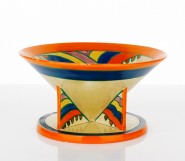Lot #20 - John Mawurndjul
-
Auction House:Bonhams Australia
-
Sale Name:Important Australian Art
-
Sale Date:25 Nov 2020 ~ 6pm (AEDT)
-
Lot #:20
-
Lot Description:John Mawurndjul
(born 1952)
Kunmadj (Dillybag), 1996
natural earth pigments on eucalyptus bark
112.5 x 59.5cm (44 5/16 x 23 7/16in).
inscribed verso: 'Mawurndjul / 5625'
RELATED WORK: Kunmadj – Milil Hunting bag, c.1988, in the collection of Museums Victoria, Melbourne, in John Altman et al., John Mawurndjul: I am the old and the new, Museum of Contemporary Art Australia, Sydney, 2018, pp. 100-101 (illus.) -
Provenance:Maningrida Arts & Crafts, Northern Territory (cat. 5625); Annandale Galleries, Sydney; Private collection, France
-
Exhibited:rarrk - John Mawurndjul : journey through time in Northern Australia, 21 September 2005 – 29 January 2006, Museum Tinguely, Basel
-
References:Christian Kauffmann (ed.), rarrk - John Mawurndjul : journey through time in Northern Australia, Crawford House Publishing Australia, Sydney, 2005, p. 118 (illus.), p. 228
-
Notes:Kunmadj refers to the finely woven collecting baskets used in Arnhem Land for a variety of foods including sugarbag (native honey). Aside from their practical use, dillybags are also of cultural significance as totemic objects associated with specific sites. One of these sites is near Milmilngkan where John Mawurndjul resides. The circular form represents the opening of the basket, but may also reference a waterhole. In a lecture given during the National Museum of Australia exhibition Old Masters, Wally Caruana discussed the 'waterhole' motif found in bark painting in detail. Caruana notes, 'The clan waterhole, which in Arnhem Land people talk about as containing the souls of all the people who have passed away: all their ancestors, parts of the souls of the living, and the souls of all those yet to be born into the clan. It's a very powerful place in terms of providing people with their identity. One of the interesting things here in bark painting is to see that clan waterhole depicted as a central part of the composition and in a sense that mimics the centrality of the clan waterhole in people's identity, in people's lives in their associations with the ancestors and especially with the country. It's that locus where people attain that identity from and where it's kept.'1 Francesca Cavazzini 1. Wally Caruana, 'Seeing Barks' for Old Masters: Australia's Great Bark Artists, lecture transcript, 5 March 2014, National Museum of Australia, Canberra
-
Estimate:A$35,000 - 45,000
-
Realised Price:
-
Category:Art
This Sale has been held and this item is no longer available. Details are provided for information purposes only.










